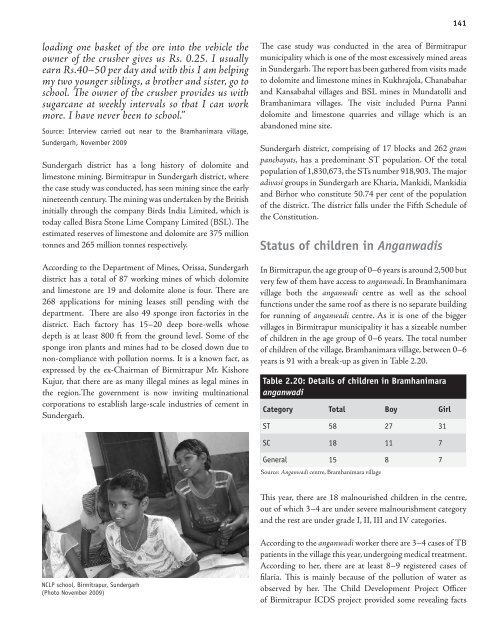Children - Terre des Hommes
Children - Terre des Hommes
Children - Terre des Hommes
You also want an ePaper? Increase the reach of your titles
YUMPU automatically turns print PDFs into web optimized ePapers that Google loves.
141<br />
loading one basket of the ore into the vehicle the<br />
owner of the crusher gives us Rs. 0.25. I usually<br />
earn Rs.40–50 per day and with this I am helping<br />
my two younger siblings, a brother and sister, go to<br />
school. The owner of the crusher provi<strong>des</strong> us with<br />
sugarcane at weekly intervals so that I can work<br />
more. I have never been to school.”<br />
Source: Interview carried out near to the Bramhanimara village,<br />
Sundergarh, November 2009<br />
Sundergarh district has a long history of dolomite and<br />
limestone mining. Birmitrapur in Sundergarh district, where<br />
the case study was conducted, has seen mining since the early<br />
nineteenth century. The mining was undertaken by the British<br />
initially through the company Birds India Limited, which is<br />
today called Bisra Stone Lime Company Limited (BSL). The<br />
estimated reserves of limestone and dolomite are 375 million<br />
tonnes and 265 million tonnes respectively.<br />
According to the Department of Mines, Orissa, Sundergarh<br />
district has a total of 87 working mines of which dolomite<br />
and limestone are 19 and dolomite alone is four. There are<br />
268 applications for mining leases still pending with the<br />
department. There are also 49 sponge iron factories in the<br />
district. Each factory has 15–20 deep bore-wells whose<br />
depth is at least 800 ft from the ground level. Some of the<br />
sponge iron plants and mines had to be closed down due to<br />
non-compliance with pollution norms. It is a known fact, as<br />
expressed by the ex-Chairman of Birmitrapur Mr. Kishore<br />
Kujur, that there are as many illegal mines as legal mines in<br />
the region.The government is now inviting multinational<br />
corporations to establish large-scale industries of cement in<br />
Sundergarh.<br />
The case study was conducted in the area of Birmitrapur<br />
municipality which is one of the most excessively mined areas<br />
in Sundergarh. The report has been gathered from visits made<br />
to dolomite and limestone mines in Kukhrajola, Chanabahar<br />
and Kansabahal villages and BSL mines in Mundatolli and<br />
Bramhanimara villages. The visit included Purna Panni<br />
dolomite and limestone quarries and village which is an<br />
abandoned mine site.<br />
Sundergarh district, comprising of 17 blocks and 262 gram<br />
panchayats, has a predominant ST population. Of the total<br />
population of 1,830,673, the STs number 918,903. The major<br />
adivasi groups in Sundergarh are Kharia, Mankidi, Mankidia<br />
and Birhor who constitute 50.74 per cent of the population<br />
of the district. The district falls under the Fifth Schedule of<br />
the Constitution.<br />
Status of children in Anganwadis<br />
In Birmitrapur, the age group of 0–6 years is around 2,500 but<br />
very few of them have access to anganwadi. In Bramhanimara<br />
village both the anganwadi centre as well as the school<br />
functions under the same roof as there is no separate building<br />
for running of anganwadi centre. As it is one of the bigger<br />
villages in Birmitrapur municipality it has a sizeable number<br />
of children in the age group of 0–6 years. The total number<br />
of children of the village, Bramhanimara village, between 0–6<br />
years is 91 with a break-up as given in Table 2.20.<br />
Table 2.20: Details of children in Bramhanimara<br />
anganwadi<br />
Category Total Boy Girl<br />
ST 58 27 31<br />
SC 18 11 7<br />
General 15 8 7<br />
Source: Anganwadi centre, Bramhanimara village<br />
This year, there are 18 malnourished children in the centre,<br />
out of which 3–4 are under severe malnourishment category<br />
and the rest are under grade I, II, III and IV categories.<br />
NCLP school, Birmitrapur, Sundergarh<br />
(Photo November 2009)<br />
According to the anganwadi worker there are 3–4 cases of TB<br />
patients in the village this year, undergoing medical treatment.<br />
According to her, there are at least 8–9 registered cases of<br />
filaria. This is mainly because of the pollution of water as<br />
observed by her. The Child Development Project Officer<br />
of Birmitrapur ICDS project provided some revealing facts






